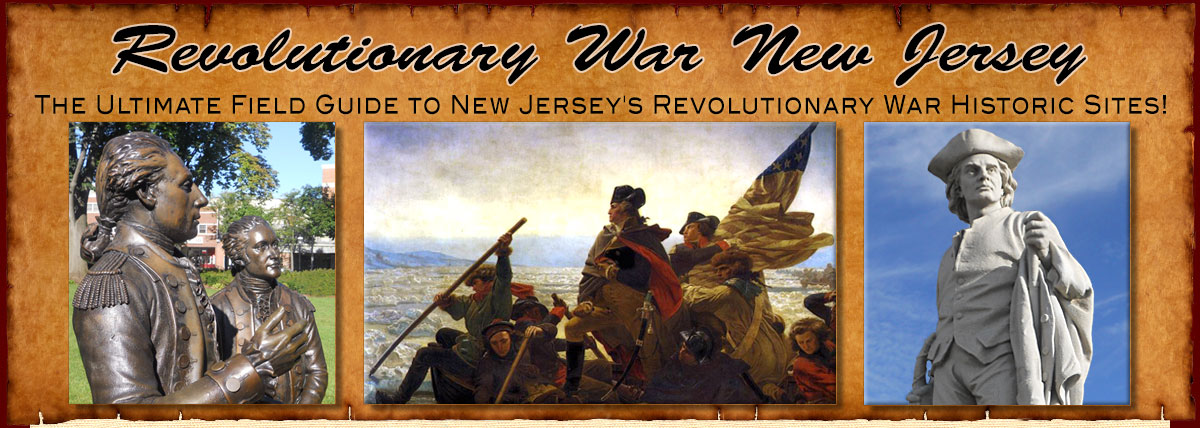

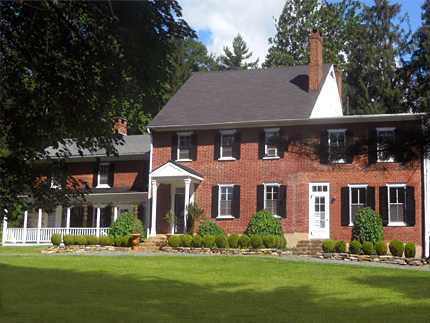
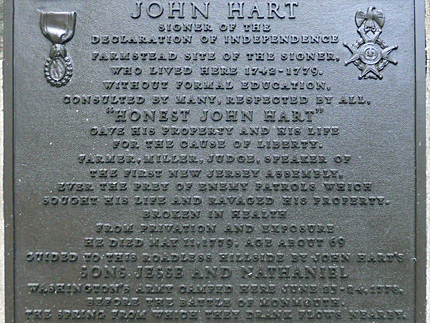
John Hart Homestead
60 Hart Avenue.
Map / Directions to the John Hart House
Map / Directions to all Hopewell Revolutionary War Sites
This house is a private residence.
Please respect the privacy and property of the owners.
John Hart - Signer of the Declaration of Independence [1]
John Hart signed the Declaration of Independence for New Jersey. The oldest portion of this house was once the home of Hart and his family; it is the smaller wing seen on the left side of the photo. The rest of the house was added in 1805, twenty-six years after Hart's death. The surrounding property was part of Hart's farmland. A plaque on a boulder monument in front of the house pays tribute to John Hart. (Shown upper right)
The exact date of John Hart's birth is unknown, but he was likely born in the autumn of 1713. He was baptized at the Presbyterian Church in Maidenhead (now Lawrenceville) Hart was a prominent political figure, before and during the Revolutionary War era. Before the war, when New Jersey was still a British colony, Hart served as a representative for Hunterdon County in the New Jersey Colonial Assembly from 1761-1771. (Hopewell was then a part of Hunterdon County. Mercer County was not formed until 1738.)
In 1776, Hart represented New Jersey at the Second Continental Congress, where he signed the Declaration of Independence. After Independence was declared, New Jersey changed from a British colony to a state, and Hart served as the new state's first Speaker of the General Assembly.
On November 19, 1776, four-and-a-half months after the signing of the Declaration of Independence, British forces invaded New Jersey, and Washington's army began a twelve-day retreat across the state from Fort Lee. During this time, John Hart and his family were forced to flee from their property because his political prominence made him a target of British forces. Hart is believed to have hidden out on Sourland Mountain in a rock formation known as the Rock House. After the American victories at Trenton and Princeton in December and January drove British forces from this part of the state, Hart and his family were able to return to their home.
June 23 - 24, 1778 / Before the Battle of Monmouth
On June 23-24, 1778, Washington's army encamped on the surrounding farmland of the Hart property several days before the Battle of Monmouth. Washington is believed to have dined in the house, most likely on June 23.
During this encampment in Hopewell, an important meeting of many of the top American officers occurred. On the morning of June 24, General Washington held an important council of war at the Hunt House, located about three miles northeast of the John Hart House. The Hunt House still stands. It is a private home on land off Province Line Road which is not visible from the road.
A total eclipse of the sun occurred on the same morning of this council of war. It was visible throughout much of the then thirteen United States from Virginia to New England. One of the surviving contemporary accounts of the eclipse was made in Philadelphia, only about forty miles from Hopewell. [2]
Note: this total solar eclipse was noted by science-minded individuals, and it was discussed in correspondence at the time, including a letter by Thomas Jefferson. For more information about this interesting topic and links to where the correspondence can be read, see source note 2.
John Hart died May 11, 1779. He is buried about a mile from here at the Hopewell Old School Baptist Meeting House Cemetery. (See next entry below.)
The Other New Jersey Signers of the Declaration of Independence
The four other Declaration of Independence signers representing New Jersey were:
• Abraham Clark, whose house is in Roselle, and his gravesite is in Rahway
• Francis Hopkinson whose house is in Bordentown
• Richard Stockton, whose home Morven, and his gravesite are both in Princeton
• John Witherspoon,whose house and gravesite, as well as a statue of him, are in Princeton
In addition:
• George Clymer, who signed for Pennsylvania, is buried in the Quaker Meeting House cemetery in Trenton
• Joseph Hewes, who signed for North Carolina was born in Princeton

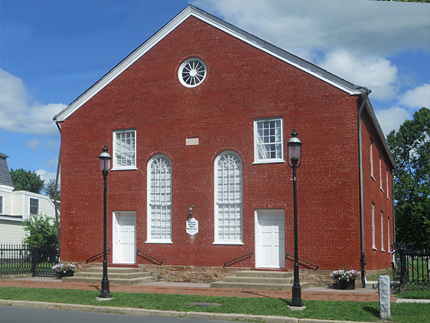
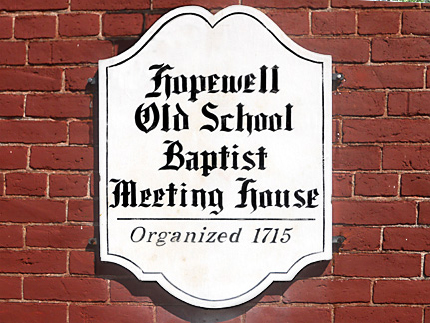
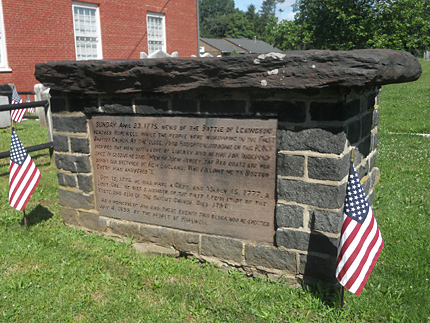
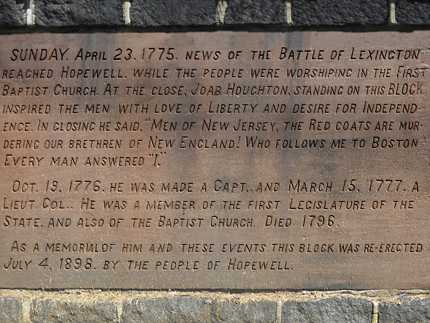
Hopewell Old School Baptist Meeting House Cemetery
West Broad St. and Mercer St.
Map / Directions to the Hopewell Old School Baptist Meeting House Cemetery
Map / Directions to all Hopewell Revolutionary War Sites
The current church building was built in 1822. It replaced an earlier church building from the 1700's which had stood here at the time of the Revolutionary War. [3]
A plaque in the cemetery (shown above) tells the story of Joab Houghton, who inspired the congregation with a speech at the beginning of the Revolutionary War, while standing on this block.. Houghton served in the war as a Captain and then a Lieutenant Colonel. After the war, he represented Hunterdon County in the New Jersey Legislature in 1785-1787. He died October 17, 1798 and is buried in this cemetery a short walk from this slab. [4]
Gravesite of John Hart, Signer of the Declaration of Independence
The cemetery also contains the gravesite of Declaration of Independence signer John Hart, whose house is located about a mile from here. (See above entry). He is buried here along with his wife Deborah Scudder Hart. An obelisk monument next to the church marks their gravesite. John Hart died May 11, 1779. The obelisk mistakenly states that he died in 1780.
Eight days after John Hart died, the New Jersey Gazette ran an obituary which shows the high esteem with which Hart was regarded: [5]
"On Tuesday the 11th instant, departed this life at his seat in Hopewell, JOHN HART, Esq; one of the Representatives in General Assembly for the county of Hunterdon, and late speaker of that House. He had served in Assembly for many years under the former government, taken an early and active part in the present revolution, and continued to the day he was seized with his last illness to discharge the duties of a faithful and upright patriot in the service of his country in general, and the country he represented in particular. The universal approbation of his character and conduct among all ranks of people, is the best testimony of his worth, and as it must make his death regretted and lamented, will ensure lasting respect to his memory."
1. ^ Information about John Hart, the house, and the army's encampment was drawn primarily from:
Cleon E. Hammond, John Hart - The Biography of a Signer of the Declaration of Independence (Newfane, VT: The Pioneer Press, 1977)▸ Regarding Hopewell as part of Hunterdon County and later Mercer County:
Mercer County was formed in 1838 from portions of Hunterdon, Burlington, Middlesex and Somerset Counties. It was named for Revolutionary War General Hugh Mercer, who died from wounds suffered at the Battle of Princeton.
Between 1838 and 1845, Hopewell went through several changes regarding its County status. Hopewell Township became part of Mercer County, was then briefly returned to Hunterdon County, and then finally was permanently returned to Mercer County.
In 1891 Hopewell Borough was formed from part of Hopewell Township.
For details see:
John F. Snyder, The Story of New Jersey's Civil Boundaries: 1606-1968 (Trenton: Bureau of Geology and Topography, 1969) pages 161-162
Available as a PDF on the State of New Jersey website here. (Note that although the information is on pages numbered 161-162 of the document, it is on pages 157-158 of the PDF file.)2. ^ Contemporary documentation for the total eclipse of the sun on June 24, 1778 can be found in a number of documents:
• Eclipse of the Sun, June 24, 1778: Observed by D. Rittenhouse, John Lukens, Owen Biddle, and William Smith, at the College of Philadelphia. Reprinted in:
William Barton, Memoirs of the life of David Rittenhouse, LLC. F.R.S. /Late President of the American Philosophical Society (Philadelphia, Edward Parker, 1813) page 591
Available to be read at Google Books here
▸ Note that these observations were made in Philadelphia, about forty miles from Hopewell“From Thomas Jefferson to David Rittenhouse, 19 July 1778,” Founders Online, National Archives (http://founders.archives.gov/documents/Jefferson/01-02-02-0071 [last update: 2015-06-29]). Source: The Papers of Thomas Jefferson, vol. 2, 1777 – 18 June 1779, ed. Julian P. Boyd. Princeton: Princeton University Press, 1950, pp. 202–204.
▸ In this letter, Thomas Jefferson writes to David Rittenhouse (the writer of the observations listed above) about both the British evacuation of Philadelphia and the eclipse.
Jefferson wrote, "I sincerely congratulate you on the recovery of Philadelphia, and wish it may be found uninjured by the enemy. We were much disappointed in Virginia generally on the day of the great eclipse, which proved to be cloudy."“To Thomas Jefferson from Rev. James Madison, 26 July 1778,” Founders Online, National Archives (http://founders.archives.gov/documents/Jefferson/01-02-02-0073 [last update: 2015-06-29]). Source: The Papers of Thomas Jefferson, vol. 2, 1777 – 18 June 1779, ed. Julian P. Boyd. Princeton: Princeton University Press, 1950, pp. 205–206.
▸ In this letter, the Reverend James Madison of the College of William and Mary (not to be confused with the Father of the Constitution and first President James Madison) writes to Jefferson about some obscuring by clouds of the early part of the eclipse, but a clearing of visibility for the end of it.
Madison wrote, "I was very glad to see your Observations, tho they differ considerably from those we made here. The same Misfortune of a cloudy Morning prevented us from seeing the Beginning, but we had a very good View of the End."
His description of the eclipse includes the wonderful sentence, "There was really something awful in the Appearance which all Nature assumed."
▸▸ It is worth noting that although Jefferson and Madison were both observing from Virginia, the College of William and Mary is about 120 miles northwest of Jefferson's home Monticello, accounting for the different weather.• The June 2004 issue of the Solar Eclipse Newsletter, (Volume 9, Issue 6) describes this eclipse as, "The first total solar eclipse recorded in the United States when the track passed from Lower California to New England... This is considered the first total solar eclipse in British Colonies and which lasted four minutes over the middle Atlantic and New England States." (Page 6)
Available to be read at the NASA website. For the link to this specific Newsletter as a PDF, click here.3. ^ The white sign on the front of the church states "Organized 1715."
A cement plaque higher on the front of the church states "Built 1717. Rebuilt 1822."4. ^ Information about Joab Houghton drawn from:
• William S. Stryker, Official Register of the Officers and Men of New Jersey in the Revolutionary War (Trenton: Wm. T. Nicholson & Co., 1872) pages 325, 342, 359
Available to be read at Google Books here• Daughters of the American Revolution Genealogical Research System, where Joab Houghton is Ancestor # A057365
• Fitzgerald's Legislative Manual State of New Jersey, Volume 145 (Trenton: By Authority of the Legislature, 1921) Page 180
Available to be read at Google Books here• Joab Houghton's gravestone in the cemetery
• The plaque on the slab in the cemetery
5. ^ The New-Jersey Gazette, Vol. II., No. 76, Wednesday, May 19, 1779, as reprinted in:
William Nelson, Editor Archives of the State of New Jersey, Second Series, Vol III (Documents Relating to the Revolutionary History of the State of New Jersey / Extracts from American Newspapers relating to New Jersey) (Trenton: John L. Murphy Publishing Company, 1906) page 380
Available to be read at the Internet Archive here